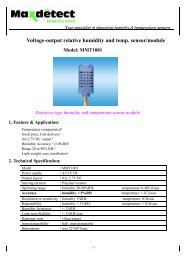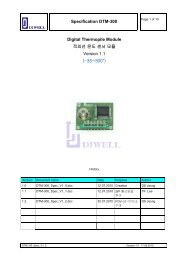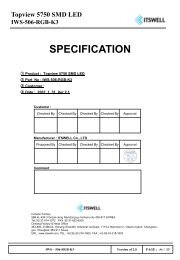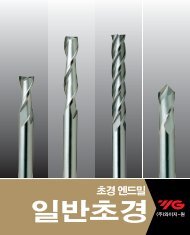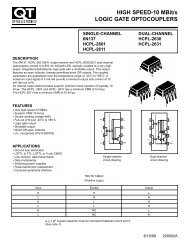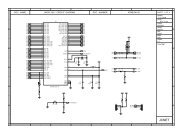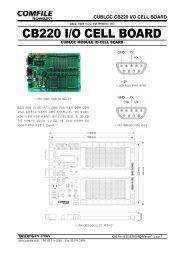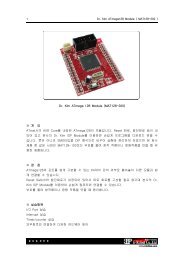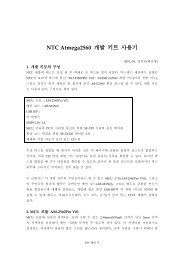QUAD/DUAL N-CHANNEL ENHANCEMENT MODE EPAD ...
QUAD/DUAL N-CHANNEL ENHANCEMENT MODE EPAD ...
QUAD/DUAL N-CHANNEL ENHANCEMENT MODE EPAD ...
You also want an ePaper? Increase the reach of your titles
YUMPU automatically turns print PDFs into web optimized ePapers that Google loves.
PERFORMANCE CHARACTERISTICS OF <strong>EPAD</strong>® MATCHED PAIR MOSFET FAMILY (cont.)<br />
SUB-THRESHOLD REGION OF OPERATION<br />
Low voltage systems, namely those operating at 5V, 3.3V or less,<br />
typically require MOSFETs that have threshold voltage of 1V or<br />
less. The threshold, or turn-on, voltage of the MOSFET is a voltage<br />
below which the MOSFET conduction channel rapidly turns off. For<br />
analog designs, this threshold voltage directly affects the operating<br />
signal voltage range and the operating bias current levels.<br />
At or below threshold voltage, an <strong>EPAD</strong> MOSFET exhibits a turnoff<br />
characteristic in an operating region called the subthreshold region.<br />
This is when the <strong>EPAD</strong> MOSFET conduction channel rapidly<br />
turns off as a function of decreasing applied gate voltage. The conduction<br />
channel induced by the gate voltage on the gate electrode<br />
decreases exponentially and causes the drain current to decrease<br />
exponentially. However, the conduction channel does not shut off<br />
abruptly with decreasing gate voltage, but decreases at a fixed rate<br />
of approximately 116mV per decade of drain current decrease. Thus<br />
if the threshold voltage is +0.20V, for example, the drain current is<br />
1uA at V GS = +0.20V. At V GS = +0.09V, the drain current would<br />
decrease to 0.1uA. Extrapolating from this, the drain current is<br />
0.01uA (10nA) at V GS = -0.03V, 1nA at V GS = -0.14V, and so forth.<br />
This subthreshold characteristic extends all the way down to current<br />
levels below 1nA and is limited by other currents such as junction<br />
leakage currents.<br />
At a drain current to be declared “zero current” by the user, the Vgs<br />
voltage at that zero current can now be estimated. Note that using<br />
the above example, with V GS(th) = +0.20V, the drain current still<br />
hovers around 20nA when the gate is at zero volt, or ground.<br />
LOW POWER AND NANOPOWER<br />
When supply voltages decrease, the power consumption of a given<br />
load resistor decreases as the square of the supply voltage. So<br />
one of the benefits in reducing supply voltage is to reduce power<br />
consumption. While decreasing power supply voltages and power<br />
consumption go hand-in-hand with decreasing useful AC bandwidth<br />
and at the same time increases noise effects in the circuit, a circuit<br />
designer can make the necessary tradeoffs and adjustments in any<br />
given circuit design and bias the circuit accordingly.<br />
With <strong>EPAD</strong> MOSFETs, a circuit that performs a specific function<br />
can be designed so that power consumption can be minimized. In<br />
some cases, these circuits operate in low power mode where the<br />
power consumed is measure in micro-watts. In other cases, power<br />
dissipation can be reduced to nano-watt region and still provide a<br />
useful and controlled circuit function operation.<br />
ZERO TEMPERATURE COEFFICIENT (ZTC) OPERATION<br />
For an <strong>EPAD</strong> MOSFET in this product family, there exist operating<br />
points where the various factors that cause the current to increase<br />
as a function of temperature balance out those that cause the current<br />
to decrease, thereby canceling each other, and resulting in net<br />
temperature coefficient of near zero. One of this temperature stable<br />
operating point is obtained by a ZTC voltage bias condition, which<br />
is 0.55V above a threshold voltage when V GS = V DS , resulting in a<br />
temperature stable current level of about 68uA. For other ZTC operating<br />
points, see ZTC characteristics.<br />
PERFORMANCE CHARACTERISTICS<br />
Performance characteristics of the <strong>EPAD</strong> MOSFET product family<br />
are shown in the following graphs. In general, the threshold voltage<br />
shift for each member of the product family causes other affected<br />
electrical characteristics to shift with an equivalent linear shift in<br />
V GS(th) bias voltage. This linear shift in V GS causes the subthreshold<br />
I-V curves to shift linearly as well. Accordingly, the subthreshold<br />
operating current can be determined by calculating the gate voltage<br />
drop relative from its threshold voltage, V GS(th) .<br />
RDS(ON) AT VGS=GROUND<br />
Several of the <strong>EPAD</strong> MOSFETs produce a fixed resistance when<br />
their gate is grounded. For ALD110800, the drain current at V DS =<br />
0.1V is at 1uA at V GS = 0.0V. Thus just by grounding the gate of the<br />
ALD110800, a resistor with R DS(ON) = ~100KOhm is produced.<br />
When an ALD114804 gate is grounded, the drain current I DS = 18.5<br />
uA@ V DS = 0.1V, producing R DS(ON) = 5.4KOhm. Similarly,<br />
ALD114813 and ALD114835 produces 77uA and 185uA, respectively,<br />
at V GS = 0.0V, producing R DS(ON) values of 1.3KOhm and<br />
540Ohm, respectively.<br />
MATCHING CHARACTERISTICS<br />
A key benefit of using matched-pair <strong>EPAD</strong> MOSFET is to maintain<br />
temperature tracking. In general, for <strong>EPAD</strong> MOSFET matched pair<br />
devices, one device of the matched pair has gate leakage currents,<br />
junction temperature effects, and drain current temperature coefficient<br />
as a function of bias voltage that cancel out similar effects of<br />
the other device, resulting in a temperature stable circuit. As mentioned<br />
earlier, this temperature stability can be further enhanced by<br />
biasing the matched-pairs at Zero Tempco (ZTC) point, even though<br />
that could require special circuit configuration and power consumption<br />
design consideration.<br />
ALD110814/ALD110914 Advanced Linear Devices 4 of 11



